Before introducing the article , Say sorry to everyone in advance , At the end of the last article , In this article, I will introduce you about using OpenCV Realize face fusion technology , Because face fusion technology requires a little more knowledge , It's not just the feature point extraction introduced before , And the triangulation mentioned in this article , Therefore, the article will be postponed a little later , But please rest assured , Face fusion technology will be scheduled in the next few articles .
See two words in the title Delaunay Triangulation and Voronoi, It is estimated that the little friend I met for the first time may look confused ( I'm talking about myself ), In order to understand these two concepts more intuitively , Please look at the chart below. :
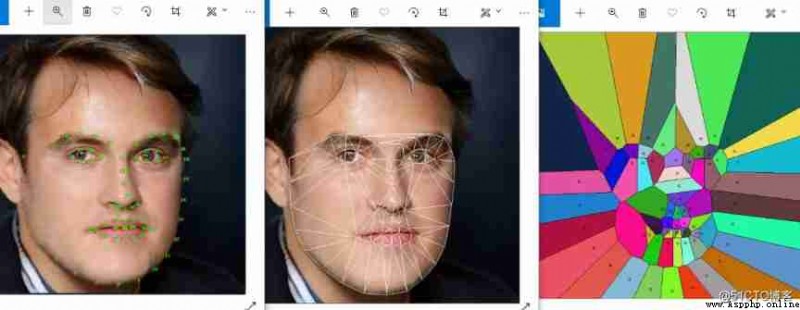 On the left :68 Personal face feature points Chinese :Delaunay Triangulation , Right picture Voronoi Chart
On the left :68 Personal face feature points Chinese :Delaunay Triangulation , Right picture Voronoi Chart
The picture on the left is mentioned in the previous article 68 Personal face feature point marking , The middle figure is based on the left figure 68 I'll do it at two points Between points Delaunay Triangulation ( Delaunay ), The left figure is drawn based on the middle figure Voronoi Diagram ( Voronoitu )
Delaunay The name of triangulation algorithm comes from Russian mathematicians Boris Delaunay, The purpose of this method is to maximize the minimum angle of triangle in triangulation , The aim is to avoid “ Extremely thin “ The appearance of triangle
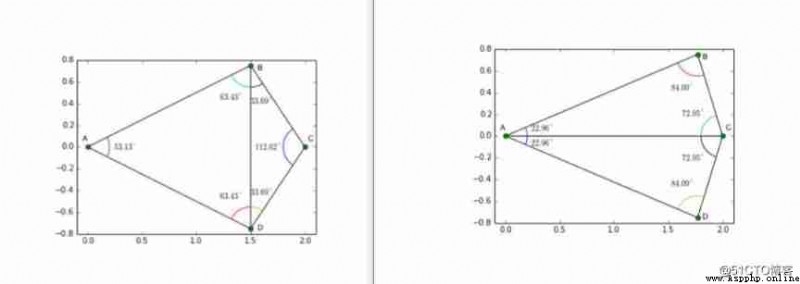
The transformation station of the left and right figures above shows Delaunay How to maximize the minimum angle , The left and right figures are two different ways of dividing the four vertices ; But in the left picture The vertices A、C Not in the triangle BCD、ABD Inside the circumscribed circle of , bring horn C A very large
The right figure has two sides of the partition form changes :1,B、D Coordinate shift right ;2, The dividing line is composed of BD Turn into AC ; Finally, the triangulated triangle is not so ” Thin “
Voronoi The name also comes from a Russian mathematician Georgy Voronoy, Interestingly Georgy Voronoy yes Boris Delaunay Doctoral tutor
Voronoi Figure is based on Delaunay Triangulation creation , take Delaunay All vertices of the partition , Connect the circumscribed center of adjacent triangles with line segments , Form an area , Adjacent different areas are covered with different colors ;Voronoi Graph is commonly used in the field of convex region segmentation
From below 20 Composed of two vertices Voronoi You can know , The distance between adjacent points in the graph is equal
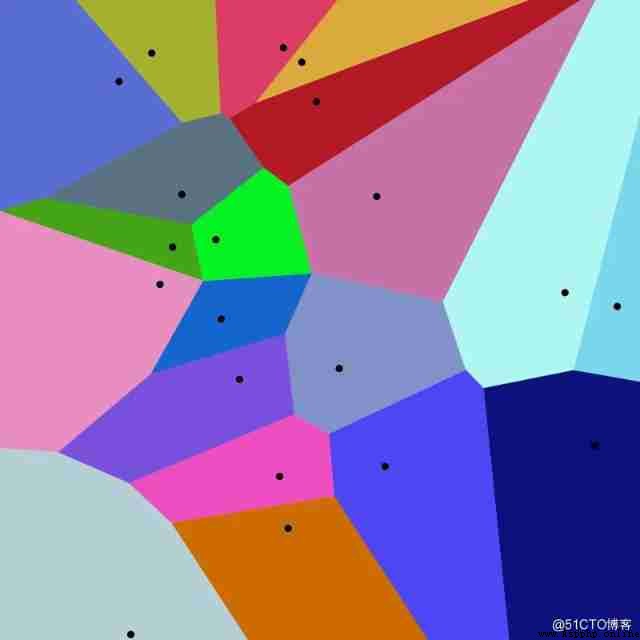 20 Composed of vertices Voronoi
20 Composed of vertices Voronoi
1, First, we need to get the face 68 Coordinates of feature points , And write txt file , Easy to use at the back , The code that will be used here
import dlib
import cv2
predictor_path = "E:/data_ceshi/shape_predictor_68_face_landmarks.dat"
png_path = "E:/data_ceshi/timg.jpg"
txt_path = "E:/data_ceshi/points.txt"
f = open(txt_path,'w+')
detector = dlib.get_frontal_face_detector()
# Collision
predicator = dlib.shape_predictor(predictor_path)
win = dlib.image_window()
img1 = cv2.imread(png_path)
dets = detector(img1,1)
print("Number of faces detected : {}".format(len(dets)))
for k,d in enumerate(dets):
print("Detection {} left:{} Top: {} Right {} Bottom {}".format(
k,d.left(),d.top(),d.right(),d.bottom()
))
lanmarks = [[p.x,p.y] for p in predicator(img1,d).parts()]
for idx,point in enumerate(lanmarks):
f.write(str(point[0]))
f.write("\t")
f.write(str(point[1]))
f.write('\n')
After writing ,txt The format in is as follows

2, Use the image size to create a rectangular range ( Because facial feature points are all in the picture ), Create a Subdiv2D example ( This class will be used in the drawing of the following two diagrams ), Insert all points into the created class :
#Create an instance of Subdiv2d
subdiv = cv2.Subdiv2D(rect)
#Create an array of points
points = []
#Read in the points from a text file
with open("E:/data_ceshi/points.txt") as file:
for line in file:
x,y = line.split()
points.append((int(x),int(y)))
#Insert points into subdiv
for p in points:
subdiv.insert(p)
3, Draw... On the original Delaunay Triangulate and preview , Here I add animation effects — Draw line by line ( It was used for loop )
#Draw delaunay triangles
def draw_delaunay(img,subdiv,delaunay_color):
trangleList = subdiv.getTriangleList()
size = img.shape
r = (0,0,size[1],size[0])
for t in trangleList:
pt1 = (t[0],t[1])
pt2 = (t[2],t[3])
pt3 = (t[4],t[5])
if (rect_contains(r,pt1) and rect_contains(r,pt2) and rect_contains(r,pt3)):
cv2.line(img,pt1,pt2,delaunay_color,1)
cv2.line(img,pt2,pt3,delaunay_color,1)
cv2.line(img,pt3,pt1,delaunay_color,1)
#Insert points into subdiv
for p in points:
subdiv.insert(p)
#Show animate
if animate:
img_copy = img_orig.copy()
#Draw delaunay triangles
draw_delaunay(img_copy,subdiv,(255,255,255))
cv2.imshow(win_delaunary,img_copy)
cv2.waitKey(100)
The preview effect is as follows :
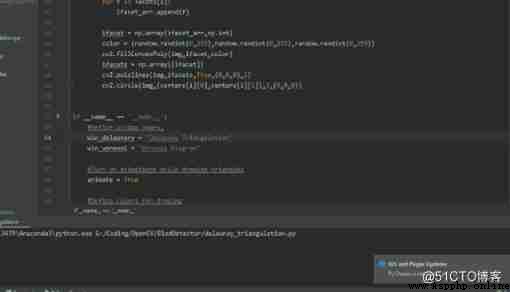
4, Finally draw Voronoi Diagram
def draw_voronoi(img,subdiv):
(facets,centers) = subdiv.getVoronoiFacetList([])
for i in range(0,len(facets)):
ifacet_arr = []
for f in facets[i]:
ifacet_arr.append(f)
ifacet = np.array(ifacet_arr,np.int)
color = (random.randint(0,255),random.randint(0,255),random.randint(0,255))
cv2.fillConvexPoly(img,ifacet,color)
ifacets = np.array([ifacet])
cv2.polylines(img,ifacets,True,(0,0,0),1)
cv2.circle(img,(centers[i][0],centers[i][1]),3,(0,0,0))
for p in points:
draw_point(img,p,(0,0,255))
#Allocate space for Voroni Diagram
img_voronoi = np.zeros(img.shape,dtype = img.dtype)
#Draw Voonoi diagram
draw_voronoi(img_voronoi,subdiv)
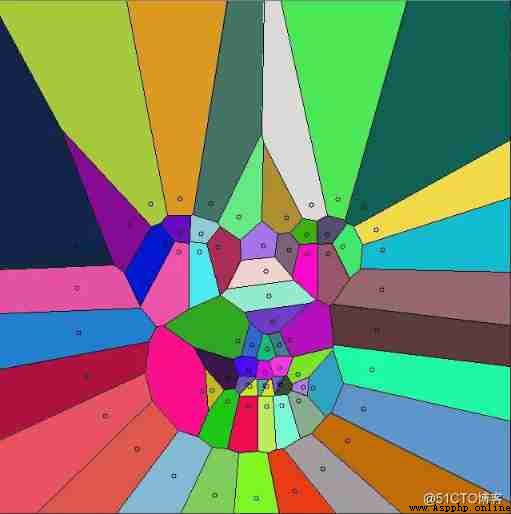
Delaunay Triangulation may not be fully understood by the little partner who comes into contact for the first time , But this segmentation technology is very important for face recognition 、 The fusion 、 Face changing is indispensable , This article is only through OpenCV Of Subdiv2D Function , The real recognition technology is much more complicated than this .
For interested partners , My suggestion is to follow the code provided , The complete code is posted below :
import cv2
import numpy as np
import random
#Check if a point is insied a rectangle
def rect_contains(rect,point):
if point[0] < rect[0]:
return False
elif point[1] <rect[1]:
return False
elif point[0]>rect[2]:
return False
elif point[1] >rect[3]:
return False
return True
# Draw a point
def draw_point(img,p,color):
cv2.circle(img,p,2,color)
#Draw delaunay triangles
def draw_delaunay(img,subdiv,delaunay_color):
trangleList = subdiv.getTriangleList()
size = img.shape
r = (0,0,size[1],size[0])
for t in trangleList:
pt1 = (t[0],t[1])
pt2 = (t[2],t[3])
pt3 = (t[4],t[5])
if (rect_contains(r,pt1) and rect_contains(r,pt2) and rect_contains(r,pt3)):
cv2.line(img,pt1,pt2,delaunay_color,1)
cv2.line(img,pt2,pt3,delaunay_color,1)
cv2.line(img,pt3,pt1,delaunay_color,1)
# Draw voronoi diagram
def draw_voronoi(img,subdiv):
(facets,centers) = subdiv.getVoronoiFacetList([])
for i in range(0,len(facets)):
ifacet_arr = []
for f in facets[i]:
ifacet_arr.append(f)
ifacet = np.array(ifacet_arr,np.int)
color = (random.randint(0,255),random.randint(0,255),random.randint(0,255))
cv2.fillConvexPoly(img,ifacet,color)
ifacets = np.array([ifacet])
cv2.polylines(img,ifacets,True,(0,0,0),1)
cv2.circle(img,(centers[i][0],centers[i][1]),3,(0,0,0))
if __name__ == '__main__':
#Define window names;
win_delaunary = "Delaunay Triangulation"
win_voronoi = "Voronoi Diagram"
#Turn on animations while drawing triangles
animate = True
#Define colors for drawing
delaunary_color = (255,255,255)
points_color = (0,0,255)
#Read in the image
img_path = "E:/data_ceshi/timg.jpg"
img = cv2.imread(img_path)
#Keep a copy around
img_orig = img.copy()
#Rectangle to be used with Subdiv2D
size = img.shape
rect = (0,0,size[1],size[0])
#Create an instance of Subdiv2d
subdiv = cv2.Subdiv2D(rect)
#Create an array of points
points = []
#Read in the points from a text file
with open("E:/data_ceshi/points.txt") as file:
for line in file:
x,y = line.split()
points.append((int(x),int(y)))
#Insert points into subdiv
for p in points:
subdiv.insert(p)
#Show animate
if animate:
img_copy = img_orig.copy()
#Draw delaunay triangles
draw_delaunay(img_copy,subdiv,(255,255,255))
cv2.imshow(win_delaunary,img_copy)
cv2.waitKey(100)
#Draw delaunary triangles
draw_delaunay(img,subdiv,(255,255,255))
#Draw points
for p in points:
draw_point(img,p,(0,0,255))
#Allocate space for Voroni Diagram
img_voronoi = np.zeros(img.shape,dtype = img.dtype)
#Draw Voonoi diagram
draw_voronoi(img_voronoi,subdiv)
#Show results
cv2.imshow(win_delaunary,img)
cv2.imshow(win_voronoi,img_voronoi)
cv2.waitKey(0)
Reference link :
https://www.learnopencv.com/